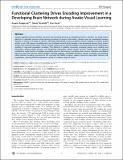| dc.contributor.author | Dunfield, Derek | |
| dc.contributor.author | Podgorski, Kaspar | |
| dc.contributor.author | Haas, Kurt | |
| dc.date.accessioned | 2012-04-26T17:04:47Z | |
| dc.date.available | 2012-04-26T17:04:47Z | |
| dc.date.issued | 2012-01 | |
| dc.date.submitted | 2011-04 | |
| dc.identifier.issn | 1544-9173 | |
| dc.identifier.issn | 1545-7885 | |
| dc.identifier.uri | http://hdl.handle.net/1721.1/70143 | |
| dc.description.abstract | Sensory experience drives dramatic structural and functional plasticity in developing neurons. However, for single-neuron plasticity to optimally improve whole-network encoding of sensory information, changes must be coordinated between neurons to ensure a full range of stimuli is efficiently represented. Using two-photon calcium imaging to monitor evoked activity in over 100 neurons simultaneously, we investigate network-level changes in the developing Xenopus laevis tectum during visual training with motion stimuli. Training causes stimulus-specific changes in neuronal responses and interactions, resulting in improved population encoding. This plasticity is spatially structured, increasing tuning curve similarity and interactions among nearby neurons, and decreasing interactions among distant neurons. Training does not improve encoding by single clusters of similarly responding neurons, but improves encoding across clusters, indicating coordinated plasticity across the network. NMDA receptor blockade prevents coordinated plasticity, reduces clustering, and abolishes whole-network encoding improvement. We conclude that NMDA receptors support experience-dependent network self-organization, allowing efficient population coding of a diverse range of stimuli. | en_US |
| dc.description.sponsorship | Canadian Institutes of Health Research | en_US |
| dc.language.iso | en_US | |
| dc.publisher | Public Library of Science | en_US |
| dc.relation.isversionof | http://dx.doi.org/10.1371/journal.pbio.1001236 | en_US |
| dc.rights | Creative Commons Attribution | en_US |
| dc.rights.uri | http://creativecommons.org/licenses/by/2.5/ | en_US |
| dc.source | PLoS | en_US |
| dc.title | Functional Clustering Drives Encoding Improvement in a Developing Brain Network during Awake Visual Learning | en_US |
| dc.type | Article | en_US |
| dc.identifier.citation | Podgorski, Kaspar, Derek Dunfield, and Kurt Haas. “Functional Clustering Drives Encoding Improvement in a Developing Brain Network During Awake Visual Learning.” Ed. Christopher C. Pack. PLoS Biology 10.1 (2012): e1001236. Web. 26 Apr. 2012. | en_US |
| dc.contributor.department | Sloan School of Management | en_US |
| dc.contributor.approver | Dunfield, Derek James | |
| dc.contributor.mitauthor | Dunfield, Derek | |
| dc.relation.journal | PLoS Biology | en_US |
| dc.eprint.version | Final published version | en_US |
| dc.type.uri | http://purl.org/eprint/type/JournalArticle | en_US |
| eprint.status | http://purl.org/eprint/status/PeerReviewed | en_US |
| dspace.orderedauthors | Podgorski, Kaspar; Dunfield, Derek; Haas, Kurt | en |
| mit.license | PUBLISHER_CC | en_US |
| mit.metadata.status | Complete | |
